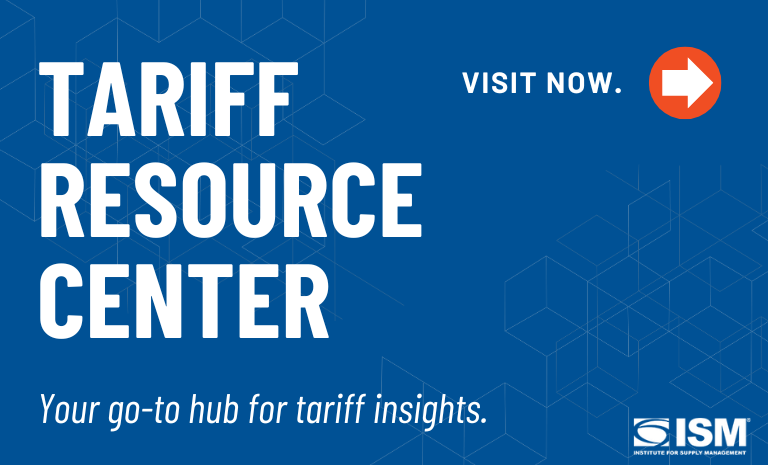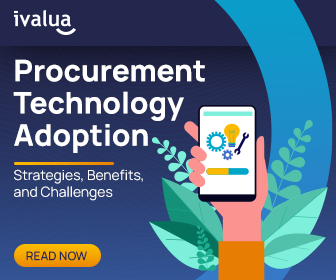Procurement Technology Adoption
Sponsored by iValua
Strategies, Benefits, and Challenges
The landscape of supply management is evolving rapidly, with procurement technology at the heart of this transformation. Forward-thinking organizations are leveraging new digital tools to boost efficiency, foster transparency, and gain a strategic edge.
But as powerful as these benefits are, adopting procurement technology isn’t a decision to be taken lightly. It requires careful planning, cross-functional collaboration, and a solid approach to change management.
Key Takeaways:
- Adopting procurement technology is a significant undertaking, requiring careful planning, stakeholder alignment, and effective change management.
- Leading companies have exceeded their goals and expectations through successful procurement technology adoption.
- As procurement undergoes a major transformation, AI-powered technology will play a pivotal role in future-proofing operations.
Why Procurement Technology Matters
Procurement technology is no longer just a nice-to-have for modern supply management teams; it’s becoming essential. Here’s why its adoption is gaining momentum:
- Efficiency Gains: Automation reduces the time spent on repetitive, manual tasks. This frees procurement professionals to focus on high-value strategies like supplier development and risk mitigation.
- Greater Transparency and Compliance: Ivalua’s procurement platform provides audit trails, improved documentation, and built-in controls. These features help drive compliance and reduce the risks of errors or fraud.
- Data-Driven Decision Making: Technology platforms gather and analyze data, empowering teams to make smarter, faster sourcing and purchasing decisions.
- Cost Savings: Identifying areas for spend optimization and negotiating with better insights directly contributes to the bottom line.
Implementing Procurement Technology
Implementing procurement technology streamlines processes, automates manual tasks, and enhances operational efficiency, leading to cost savings. It also provides real-time data and insights, enabling better decision-making and improved supplier relationships. Furthermore, advanced procurement technology ensures compliance with regulations and mitigates risks by offering greater visibility and control over the entire supply chain.
When choosing Source-to-Pay Software, organizations must take into account numerous factors that impact success. Too often, hidden factors become roadblocks when it’s too late.
Benefits of Procurement Technology
Digitizing and automating tasks across the entire Source-to-Pay (S2P) process unlocks savings opportunities, increases spend visibility to reduce maverick spending, and strengthens supplier relationships.
These are just a few of the significant benefits that procurement technology provides, enabling organizations to optimize efficiency, enhance compliance, and drive strategic value. The rise of advanced AI capabilities and autonomous agents can take procurement’s strategic impact to yet another level.
What’s Next? The Future of Procurement Technology
Trade tensions, evolving regulations, and supply chain disruptions are driving a fundamental shift in procurement management. The most impactful trend resulting from these challenges is the increased use of AI. Companies that adopt AI innovations will gain a competitive edge by enhancing efficiency and reducing risk, while those that fail to adapt risk falling behind. In this changing landscape, strong governance and proactive risk management are essential to maintaining secure and resilient supply chains.
From AI-driven automation to regulatory compliance and supply chain transparency, procurement leaders are leveraging technology to navigate today’s challenges and future-proof their operations.
- AI Integration: AI-driven sourcing tools are analyzing massive amounts of data to help organizations identify the best suppliers, predict market trends, and optimize their sourcing strategies. AI can automate contract creation, track compliance, and flag potential risks, as well, cutting down on manual work and reducing costly errors.
- Sustainability & Compliance: While some businesses may scale back formal ESG programs, cost-conscious and risk-averse companies are still incorporating sustainable sourcing, ethical labor practices, and governance transparency–and they are now under the umbrella of “efficiency and risk management.” Procurement leaders must navigate these murky waters to keep sustainability and ethical sourcing at the top of the priority list, despite the changing terminology.
- Transparency & Visibility: A third key area is geopolitical tensions, which are now a daily reality. Achieving full transparency across the entire supplier base—beyond Tier 1 to include Tier 2 and Tier 3—is essential for mitigating risks and ensuring supply chain resilience. As global uncertainties continue to grow, this level of visibility will only become more critical.
Best Practices for Successful Adoption
We know why procurement technology isn’t just a technical upgrade; it’s a strategic shift. To maximize the benefits:
- Plan Carefully: Map processes, define clear objectives, and build a phased adoption plan.
- Get Stakeholder Buy-in: Engage procurement, IT, finance, and key business owners early to ensure alignment.
- Focus on Change Management: Proactively manage change with communications, training, and clear success metrics.
Conclusion
Adopting procurement technology is no longer optional for procurement teams looking to stay competitive. The right digital tools can unlock efficiency, transparency, and value, while advanced capabilities like AI and end-to-end visibility are quickly becoming a necessity.
Forward-thinking organizations that invest in procurement technology today aren’t just keeping up; they’re setting the standard for tomorrow’s supply chain.
Visit our homepage to find out more about Ivalua’s AI-powered Source-to-Pay platform!

